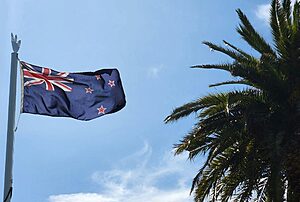By Ian Wishart
In brief
- NIWA appears to have misled Parliament and Minister Ayesha Verrall regarding missing storm data in the Climate of Fear study. It claimed no data was missing without verifying this.
- Documents released under the Official Information Act show NIWA did not thoroughly analyze the Climate of Fear study. It didn’t review 26 historical storm events mentioned, including 21 flagged as missing from NIWA’s database
- Senior management’s failure to address criticism from the study raises doubts about NIWA’s competence, integrity, and adherence to information laws, impacting its reputation as a reliable climate research organisation.
Deep dive
NZ climate research agency NIWA appears to have misled Parliament and its then-Minister Ayesha Verrall last year as it battled to limit damage from the Climate of Fear study into missing historical storm data.
Nearly 900 pages of documents have been released by NIWA to the Centrist, and while the contents are serious (and covered in a Part 2), perhaps the most damning revelation is what’s missing from the documents: any analysis of the mega-storm data published in the Climate of Fear report itself.
The issue is crucial to the integrity of NIWA, because it reassured its Minister on 3 March 2023 that there was nothing to see in the Climate of Fear report, no data was missing, and it repeated that claim in answers to formal parliamentary questions.
NIWA also purported to debunk the CoF study in a series of statements to the news media and then on the NIWA website itself.
The problem? There’s no evidence in the 884 page OIA document drop that NIWA even read the study, let alone carried out a point by point analysis of each of the 26 historical storm events listed in the CoF study, 21 of which were listed in the study as “missing” from NIWA’s Historical Weather Events (HWE) database, often used by media and researchers.
While it’s remotely possible (but highly unlikely, for reasons I’ll come back to) that the weather data was captured in NIWA’s main database, “CliFlo”, no one would know unless NIWA searched, and based on the document trail NIWA never looked.
On the morning of Friday, 3 March 2023, the Ministry of Business, Innovation and Employment (MBIE), emailed NIWA to say the Minister had been asked to comment on the CoF study, and the Minister’s office wanted answers:
“MO urgently requesting a few talking points on NIWA on the enquiry below. Specifically, is data missing, if so why, and is anything being done in future to address this.”
MBIE then advised the Minister was also being required to reply to two parliamentary questions from National MP Stuart Smith:
• “PQ 4083 (2023) – Does the Minister have confidence that the National Institute of Water and Atmospheric Research will manage weather and climate records?
• “PQ 4084 (2023) – Has the National Institute of Water and Atmospheric Research lost historical weather records, if so, what is missing?”
According to the documents released by NIWA under the OIA, nothing was missing:
“The response to PQ 4084 is that NIWA has not lost any historical weather records.”
The answer provided by NIWA to the Minister was false, even from just a cursory glance. Of the 600 or so weather stations operated by NIWA and MetService across New Zealand, only seven (7) have a continuous temperature record since 1909. New Zealand’s hottest year claims are based on just seven out of 600 stations, because the historical data from most other stations is missing. Even then, the seven-station series can’t go back before 1909. The Climate of Fear study was concentrating on mega-storms, each at least as big as Cyclone Bola and many much larger even than Gabrielle, which slammed NZ between 1868 and 1890 at the rate of one each year.
So when NIWA gave Minister Verrall this answer to Parliament, it was false and NIWA knew it was false:
“Hon Dr Ayesha Verrall (Minister of Research, Science and Innovation) replied: I am advised that the National Institute of Water and Atmospheric Research has not lost any of New Zealand’s official weather and climate records.”
The eagle-eyed among you may have spotted that NIWA’s “…not lost any historical weather records” had changed to “…official” records by the time it appeared in the parliamentary papers, but that doesn’t save them: the NZ Met Service has collected official records since the 1860s, but much of the data from the 1800s is now missing.
But there’s an even bigger problem for NIWA: when it told the minister nothing was missing in the context of the CoF data, it hadn’t actually looked.
The mutually agreed OIA question was robust enough to encompass anything NIWA staff had written about Climate of Fear: “any internal working analysis, instructions and vetting of our response, any internal messages between NIWA staff or to external colleagues discussing the article”.
On 2 March 2023 as social media started to explode, you would think NIWA management would have recognised the credibility hit the climate research organisation was taking and ordered an urgent review. Staff on the ground knew they were under fire, with one remarking on the morning of 3 March, “It’s gaining wings”.
In the almost 900 pages released, you would expect to see a memo from management requesting a report on what the CoF study was accusing NIWA of missing.
No such memo exists. At no point did senior management take control of the crisis.
No report was ordered, or delivered, that said, ‘the CoF study alleges 24 mega-storms (equal to or greater than Cyclone Bola in strength) hit NZ in the 22 years between 1868 to 1890, and we have found X of those storms in our database’.
Had NIWA CEO John Morgan demanded and obtained such a report, he would have had an informed factual foundation to reassure the Minister and Parliament. But that analysis was never done, and without it Morgan and NIWA were flying blind.
Instead, it was left to NIWA’s comms team, assisted by climate scientists Drew Lorrey and Ben Noll and others, to draft essentially off-the-cuff responses anchored in pedantry about which database NIWA used for its government climate advice [spoiler alert: 80% of the mega-storms were missing from one database, and may well have been missing from the other given NIWA’s own admission that its national weather data from the 1800s is extremely patchy. The main CliFlo database contains raw datapoints like temperature, rainfall, wind and barometric pressure on a given date but does not appear searchable by event description. It also has extremely limited geographical coverage and certainly does not contain the level of nationwide daily weather data and eyewitness reports that old newspapers from the 1800s do, which meant Climate of Fear could track a storm system affecting the entire country, whereas all NIWA might see in CliFlo was bad weather in Auckland.]
Proof that NIWA had never read Climate of Fear despite assuring Parliament and the Minister there was nothing to see came in this NIWA release to the Herald on 9 March 2023, which became part of NIWA’s official public statement on its website:
“Examining the significance of a weather event like Gabrielle extends well beyond a single meteorological metric. Atmospheric pressure, which Wishart has focused on, is only one way of measuring a storm’s intensity and wind strength. NIWA typically examines several factors to describe a cyclone’s intensity in its climate summary, including rain, wind, and sea-related impacts.”
Had the NIWA scientist who wrote the agency’s official rebuttal of Climate of Fear read the study beforehand, they would never have made the error of saying it only relied on one “single meteorological metric…Atmospheric pressure”. The entire study carried graphic eyewitness descriptions of exactly what NIWA was looking for: “rain, wind and sea-related impacts”.
So what took place? There appear to be two possible explanations, given the robust OIA catch-all question: either NIWA didn’t read the study and misled its political masters, or it did do a fact-check analysis and is deceptively concealing it in breach of official information law. The outcome is equally bad for NIWA either way. The second option is highly unlikely because, as pointed out to NIWA CEO John Morgan, not only has no baseline report been disclosed in the document dump, but nor is there “any reference to the existence of such a core document in any of the scrabbling around for response content leading up to the final version published by NIWA on 10/3/23.”
In other words, even if a core analysis was being hidden now, its shadow should appear in other key documents from the time, like the answer to the Minister. The shadow isn’t there.
NIWA, its CEO John Morgan, former minister Ayesha Verrall and MBIE have all been approached for comment. MBIE has since responded, saying “this is an operational matter for NIWA and its board”.
AUTHOR’S VIEW: NIWA’s actions, in purporting to rebut and discredit a study that it never actually read during that process, raise serious questions about the organisation’s competence, integrity and judgment. Telling its minister and parliament that “NIWA has not lost any historical weather records” when it had not bothered to check what “historical weather records” it was accused of misplacing is extraordinary and may well have deeper repercussions.
Image: NASA’s Terra Satellite Saw Tropical Storm Zelia Fizzling Enroute to New Zealand

























